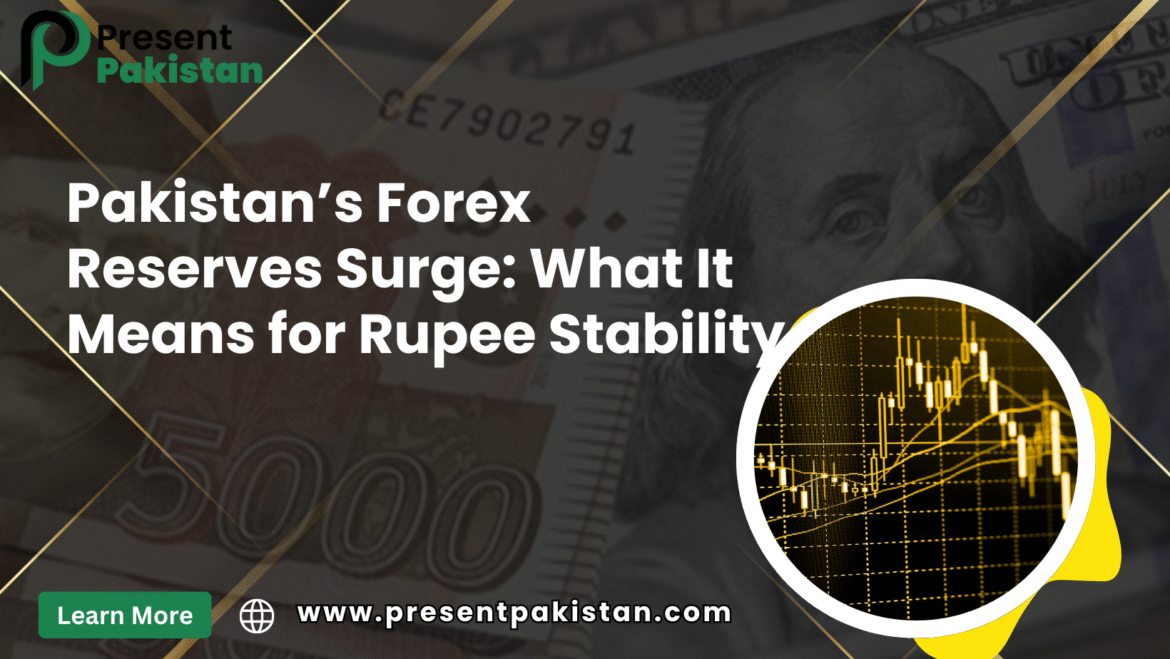Pakistan’s foreign exchange reserves have recently shown a remarkable increase, marking a turning point in the country’s economic stabilization. As of August 2025, total liquid reserves rose to $20.03 billion, a 39-month high, with correspondingly total SBP reserves at around $14.5 billion and commercial banks’ reserves at about $5.5 billion (Gulf News, The Express Tribune). After several years of decline, including the low point in the middle of 2023 when Pakistan’s reserves had dropped to a terribly low 4 billion, this is a comeback worth writing about, which answers the question of where it is coming from, its effects on the Pakistani rupee, and hopefully a complete view of the horizon for macroeconomic stability.
2. Background & Timeline
Mid-2023 Issues
Pakistan’s reserves fell below $4 billion, just a few weeks of import cover, causing fears of sovereign default. Arab News—Wikipedia.
Rebound Begins
By the end of June 2025, SBP reserves were at $14.51 billion, an increase of $5.12 billion from the previous fiscal year, an import cover of 2.5 months, according to Arab News.
July Surge
There was a large jump in July, where reserves reached $20.03 billion, the highest level since March 2022, due in large part to the very robust remittance inflows, especially from the UAE Gulf News and The Express Tribune.
Last few weeks
As of mid-August, total reserves have been stabilized at $19.5-19.6 billion, with SBP reserves around $14.24 billion, with the rest coming from the commercial banks (Arab News, The Express Tribune).
3. Key Drivers of Reserve Surge
- Remittances (Key Engine)
A significant contribution to the reserves almost all came from remittances through formal channels, especially from the UAE, resulting in reserves climbing to 39-month high. Gulf News
- IMF Support
The SBP received in May 2025 over $1 billion in IMF backed Special Drawing Rights (SDRs) (Xinhua News). In securely exceeding the IMF target of June, it contributed to building confidence and strengthened shows of macro stability, Arab News.
- Export Growth & Structural Reforms
Export-led growth strategies, IMF reforms and efforts to formalize revenue from forex sources enabled the sustained rebound. Arab News AInvest.
- Policy Interventions
Crackdowns on dollar black-market trading, including ISI raids, led to a positive official rate and political will to discourage speculative channels. Reuters +1.
- Debt Rollovers
China’s rollover of a $3.4 billion commercial loan commitment (including a $2.1 billion deposit into SBP) helped the IMF secure the target of $14 billion in reserves by June, Wikipedia.
4. Consequences For Rupee Stability
Import Cover & Buffer
If reserves improve so that they can provide import cover of 2.5 months instead of previously at critical levels, the economy is less vulnerable to external shocks. Arab News.
Currency Confidence
Higher reserves lend to investor and market confidence and reduce speculative pressures on the rupee, possibly reducing volatility. Wikipedia – Atlantic Council.
Black-Market Pressure Reduced
Crackdowns on black-market currencies have temporarily given the rupee a little strength by reducing the “premium” that a parallel market adds; however, how much of this is durable will depend on the effectiveness of the enforcement and the flows through formal (non-black) channels. Reuters +1.
Inflation & Rates
With SBP’s pause on reducing rates (currently at 12%), the policy will be cautious and allow for stability while inflation declines from previously high levels. Reuters.
A stable rupee will reduce imported inflation, dampening CPI increases.
Forex Market Trends
Rates quoted in the interbank and open market are merging around Rs 281–286 illustrating better alignment and reduced speculation. ACAD.
5. Risks & Challenges
- Sustainability of Remittances
When remittance flows slow reserves are thin, and the continued reliance on earnings from overseas makes for a tenuous situation.
- Debt & Rollovers
A reliance on rollovers (e.g., from China) creates a debt sustainability issue. Wikipedia.
- Political Instability
Political developments could scare the market, create policy uncertainty, and reduce capital inflows.
- Export Performance
Sustaining export growth is critical; any slowdown creates challenges for an accumulation of reserves.
- Institutional Coordination
In order to maintain enforcement (e.g., with respect to informal forex), institutional coordination is required.
6. Outlook & Policy Recommendations
- Diversity Reserves: Create export diversification opportunities, assist the diaspora to use formal channels for remitting, and proactively seek FDI that could potentially enhance trade.
- Debt Restructuring & Fiscal Discipline: Resume normal servicing of debt, actively work towards more sustainable debt, and meaningfully limit the use of roll-over.
- Maintain Policy Discipline of Forex: Keep informal markets orderly with enforcement and with communication to SBP.
- We have usable examples of export-led growth initiatives: the Government’s “Uraan Pakistan” strategy regarding ICT exports, manufacturing and remittances should be fully activated. Wikipedia.
- Macroeconomic reform. Continue the relationship with the IMF, gradually slow inflation rates, and improve tax collection capacity to allow domestic industries to take hold.
7. Conclusion
Pakistan’s forex reserves have made a remarkable recovery, from extreme lows to over $20 billion, restoring credibility and stabilizing the rupee at a critical time. However, continuing the upward trend requires balanced growth, debt management, and policy discipline.
More than ever, all stakeholders in Pakistan, from policymakers to businesses and citizens, need to be informed.
See [PresentPakistan.com, Finance] for analysis, weekly updates, and views about the future. Make sure you subscribe, and you will never miss out on the end economic developments that will shape it.
FAQs
Q1: What are Pakistan’s current forex reserves in 2025?
In August 2025 Pakistan has approximately $19.5 -20 billion in total liquid forex reserves, the highest amount for the last 3 years.
Q2: Does the increasing forex reserve have an effect on the Rupee?
More capable forex reserves will improve confidence in the Rupee, reduce speculation, and provide stability since this means we will have cover for more imports.
Q3: What role do remittances have in Pakistan’s forex reserves?
Overseas remittances provide many of the forex reserves and bring billions of dollars a year, especially from Gulf countries, namely the UAE and Saudi Arabia.
Q4: Can Pakistan maintain the pace of growth of the forex reserves?
The growth is sustainable provided remittance inflows remain consistent and export growth increases, as well as good debt management and political stability.
Q5: Why is Rupee stability important to ordinary Pakistanis?
Rupee stability means more stable inflation to keep imports down, and makes it simpler for businesses to plan their operations.
People Also Ask
Q1: Why do forex reserves matter to Pakistan’s economy?
Foreign currency reserves play a critical buffering role in Pakistan’s economy by allowing payments for essential imports such as oil, machinery and food; providing a capacity to service external debt; and improving overall confidence of investors. Reserves reduce the risk of being exposed to currency shocks from depreciation of the Pakistani Rupee (PKR) versus the foreign currencies whilst also reducing the exposure to the volatilities of global market dynamics so that the economy is more stable.
Q2: What is the relationship of forex reserves with Rupee (PKR) stability?
In terms of PKR stability, when reserves are at a strength, PKR has strength, as the SBP has the market influence capacity to intervene in the market when deemed necessary. When this occurs, speculative shocks to the currency market are largely eliminated, panels of banker currency rates are reduced between willing rates and open market rates, and inflation is reduced by stabilizing impacts of import prices.
Q3: Why did Pakistan’s forex reserves increase in 2025?
A combination of growth in remittances, disbursement inflows from the IMF, favourable rollover debt from friendly countries and serious policy effort on black-market dollars resale contributions brought about a significant increase of forex reserves in Pakistan in 2025. Remittances from the UAE and Saudi Arabia have been a large amount of contributions.







